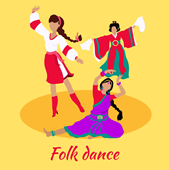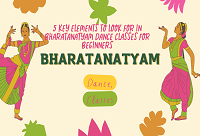Difference between Bharatanatyam and Kuchipudi

Dance is a beautiful form of art that expresses emotions, stories, and cultures through movements and gestures. India has diverse and rich dance forms that reflect its heritage and history. Two of the most popular and classical dance forms in India are Bharatanatyam and Kuchipudi. These dance forms have unique features, styles, and origins. In this blog, we will explore the difference between Bharatanatyam and Kuchipudi and learn more about their significance and beauty.
What is Bharatanatyam?
Bharatanatyam is a classical dance form that originated in the southern state of Tamil Nadu. It is one of India's oldest and most revered dance forms, dating back to ancient times. The name Bharatanatyam comes from the combination of three Sanskrit words: Bhava (expression), Raga (music), and Tala (rhythm). Bharatanatyam is a dance form that showcases the harmony of these three elements through intricate footwork, hand gestures, and facial expressions.
Bharatanatyam is mainly performed by female dancers who wear colorful costumes, traditional jewelry, and elaborate makeup. The costumes consist of three fans of different lengths, creating the impression of a pleated sari. The jewelry includes earrings, necklaces, bracelets, anklets, and a waistband. The makeup highlights the eyes and the eyebrows to enhance the expressions.
Bharatanatyam is a dance form that depicts religious themes and spiritual ideas from Hinduism, especially Shaivism, Vaishnavism, and Shaktism. The dance is performed to classical Carnatic music that accompanies the dancer's movements and emotions. The dance has two main aspects: Nritta (pure dance) and Nritya (expressive dance). Nritta involves rhythmic and geometric patterns of movements that display the dancer's skill and grace. Nritya involves expressive gestures and poses that convey the meaning and mood of the song or story.
What is Kuchipudi
Kuchipudi is a classical dance form that originated in the southeastern state of Andhra Pradesh. It is named after a village called Kuchipudi, where Brahmin dancers developed it in the 17th century. Kuchipudi is a dance form that combines drama, music, and dance to narrate stories from Hindu epics and mythology.
Kuchipudi is performed by male and female dancers who wear simple yet elegant costumes that suit their characters. The costumes are usually made of silk or cotton fabrics with bright colors and designs. The minimalistic jewelry consists of earrings, necklaces, bangles, and toe rings. The makeup is natural and subtle to highlight the features of the face.
Kuchipudi is a dance form emphasizing storytelling and emotion through fluid and graceful movements. The dance is performed to classical Hindustani or Carnatic music that matches the tempo and tone of the story. The dance is divided into two main aspects: Nritta (pure dance) and Abhinaya (expressive dance). Nritta involves lively footwork that creates sounds with bells or anklets worn by the dancer. Abhinaya involves facial expressions, hand gestures, and body language that communicate the message and emotion of the story.
Differences between Bharatanatyam and Kuchipudi
Bharatanatyam and Kuchipudi are both classical dance forms with many similarities in their origin, theme, music, and aspects. However, they also differ in style, technique, costume, and expression. Some of the main differences are:
- Bharatanatyam is more precise and geometrical, emphasizing symmetry and form; Kuchipudi is more fluid and expressive, emphasizing storytelling and emotion.
- Bharatanatyam costumes feature bright colors, traditional jewelry, and intricate makeup; Kuchipudi outfits are more minimalistic, focusing on simple yet elegant designs.
- Bharatanatyam is called the fire dance that reflects the inner fire within the human body; Kuchipudi symbolizes the unification of the human soul with the cosmic soul.
- Bharatanatyam has three fans of different lengths in its costume; Kuchipudi has only one longer than the most extended fan in Bharatanatyam.
- Bharatanatyam has more sculpted poses that resemble the sculptures of ancient temples; Kuchipudi has more rounded poses that resemble the paintings of medieval times.
Bharatanatyam and Kuchipudi are beautiful and graceful dance forms that showcase India's rich and diverse culture. They are both forms of art that express emotions, stories, and cultures through movements and gestures. They are both forms of worship that honor and celebrate the divine and the spiritual. They are both forms of joy that inspire and delight the audience and the performer.
If you want to learn or teach Bharatanatyam or Kuchipudi, you can find the best dance services on Sulekha. Sulekha is a leading online platform that connects you with verified and experienced dance teachers, trainers, studios, and events in the USA and Canada. You can browse the profiles, ratings, reviews, and photos of the dance teachers and dance schools and choose the one that suits your needs and preferences. You can also book your service online or by phone at any time convenient. You can also get discounts and offers on your bookings.
Sulekha is your one-stop destination for all your dance needs. Whether you want to learn or teach Bharatanatyam or Kuchipudi, Sulekha will provide you with the best service possible. So what are you waiting for? Book your service today and get ready to experience the beauty and grace of Bharatanatyam or Kuchipudi!
Searching for Dance Classes? Let’s make your search simple with professionals!
Take your Dance Classes to the next level with Sulekha. Boost your online visibility, connect with more clients, and grow effortlessly!
Blogs Related to Dance Classes

Best Tips to Master Salsa Dance Classes
Salsa dancing is not just a dance; it’s a vibrant expression of culture, rhythm, and joy! Whether you’re a complete beginner or looking to refine your skills, mastering salsa can be an exhilarating journey. At Sulekha Dance Services, we believe that

Indian Dance Classes for Beginners- Breaking down Barriers and Building Confidence
Introduction to Indian Dance Indian dance

Folk Dance Classes for Kids: Building Cultural Awareness and Appreciation
Dance is more than just movement; it's a celebration of culture, history, and tradition. For kids, learning folk dances provides a unique opportunity to connect with their roots, appreciate diversity, and develop a sense of belonging. At Sulekha Danc

Bollywood Dance Classes: A Fun and Energetic Way to Stay Fit
Groove to the Rhythm In the heart of bustling cities, where neon lights flicker and music reverberates through the streets, Bollywood dance classes come alive. These vibrant sessions blend fitness with the infectious beats of Hindi cinema, creating

5 Key Elements to Look for in Bharatanatyam Dance Classes for Beginners
Embarking on the journey of learning Bharatanatyam

How to Choose the Right Kathak Dance Class for Your Skill Level
Finding Your Rhythm: Choosing the Ideal Kathak Dance Class for You Kathak's fascinating expressions, rhythmic footwork, and captivating spins make it one of the most graceful Indian classical dance forms. As this ancient North Indian art form contin

